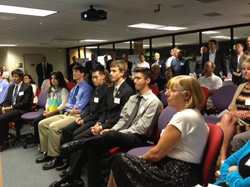 By Rob Chudzik.
By Rob Chudzik.
 Republished with permission of UConn Today.
Republished with permission of UConn Today.
Three-dimensional printing has garnered coverage in the popular press for its application in the custom manufacturing of tools and mechanical parts. But six School of Engineering seniors have recently taken the application of the technology into the medical field, using 3-D printing to create body parts.
Under the direction of Anson Ma, assistant professor in the Department of Chemical and Biomolecular Engineering and the Institute of Materials Science, two three-person teams of chemical engineering students were tasked with creating an artificial kidney for their Senior Design Project using 3-D printing technology. 3-D printing is an additive manufacturing method capable of creating complex parts that are otherwise impossible or extremely difficult to produce.
The students participating were: Derek Chhiv, Meaghan Sullivan, Danny Ung, Benjamin Coscia, Guleid Awale, and Ali Rogers. They are one of the first classes of students to partner with a commercial 3-D printing company, ACT Group, to create a prototype.
The challenge the teams set out to tackle is rooted in a very real problem.
The United States Renal Data System reports that, as recently as 2009, End-Stage Renal Disease (ESRD) resulted in over 90,000 deaths. Options for treatment of renal disease are essentially limited to either an organ transplant or dialysis. However, there is a limited supply of transplantable kidneys, with demand far outstripping the supply; and dialysis is expensive and is only a temporary solution.
According to data from the National Kidney Foundation, there are currently nearly 100,000 people awaiting kidney transplants in the United States, yet only 14,000 kidney transplants took place in the country this year. An additional 2,500 new patients are added to the kidney waiting list each month. Faced with these challenges, the two UConn teams set out on a year-long effort to design and develop a prototype of a cost-effective, functional artificial kidney using chemical engineering principles and 3-D printing technology.
“The objective of the design project is to get these students to combine the latest technology and their chemical engineering knowledge, learned over their four years at UConn, to solve a technical problem where we can make a difference,” notes Ma. “Can they push the technology further?”
Guleid Awale, one of the seniors, said the two design teams each took a slightly different approach to the problem. “While the other team utilized techniques such as electrodialysis and forward osmosis in their prototype, our group opted for mainly hollow fiber membrane technology commonly found in traditional hemodialysis treatments.”
Benjamin Coscia ’14 (ENG) explains the hollow fiber membrane technology: “Because 3D printing resolutions are not currently low enough to print a structure which will actually filter blood, the file is of only the shell of the kidney. Hollow fiber membranes will be installed on the inside to do the filtration function. The kidney will then be sealed together using the threads and sealing o-rings. A fluid called dialysate will be circulated on the outside of the membranes, inside of the shell, which will cause flux of components from the blood. A waste stream maintains the person’s ability to urinate. The outside of the shell can be used as a substrate for growth of biological material for ease of integration into the body.”
After undertaking the research and development of the design, the teams designed the prototype using AutoCAD software. Then each team collaborated with UConn technology partner ACT Group of Cromwell, Conn. to select the appropriate polymers, as well as the right printer to use in printing the particular prototype design.
The two teams presented their projects on May 2 at the School of Engineering Senior Design Demonstration Day.
“The biggest challenge in approaching the project was applying the engineering knowledge we’ve gained during our undergraduate years to a more complex biological application,” Awale notes. “This forced us to come out of our comfort zone and rely on our problem-solving skills in order to come up with viable solutions.”

 The Department of Chemical & Biomolecular Engineering was the proud host of the 2014 Northeast Student Regional Conference for the American Institute of Chemical Engineers on April 4-5, 2014. The event attracted more than 300 undergraduate chemical engineering students from 21 schools, traveling from as far as McGill, Cornell and Maine, to as near as UMass and the University of New Haven.
The Department of Chemical & Biomolecular Engineering was the proud host of the 2014 Northeast Student Regional Conference for the American Institute of Chemical Engineers on April 4-5, 2014. The event attracted more than 300 undergraduate chemical engineering students from 21 schools, traveling from as far as McGill, Cornell and Maine, to as near as UMass and the University of New Haven.





 The Research Experience for Undergraduates (REU) program provides undergraduates with exposure to a stimulating research environment.
The Research Experience for Undergraduates (REU) program provides undergraduates with exposure to a stimulating research environment.
 The chemical engineering graduate program at the University of Connecticut is comprised of bright, innovative leaders who are motivated by change and challenge. The program offers the opportunity for students to enhance their skills and develop their potential.
The chemical engineering graduate program at the University of Connecticut is comprised of bright, innovative leaders who are motivated by change and challenge. The program offers the opportunity for students to enhance their skills and develop their potential.

